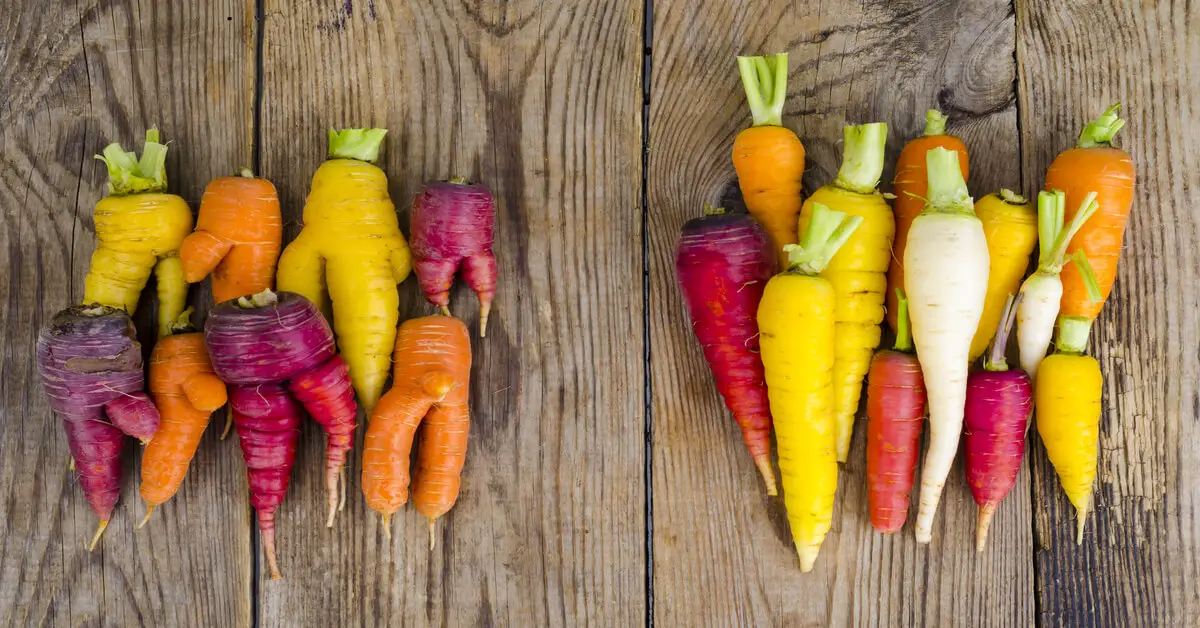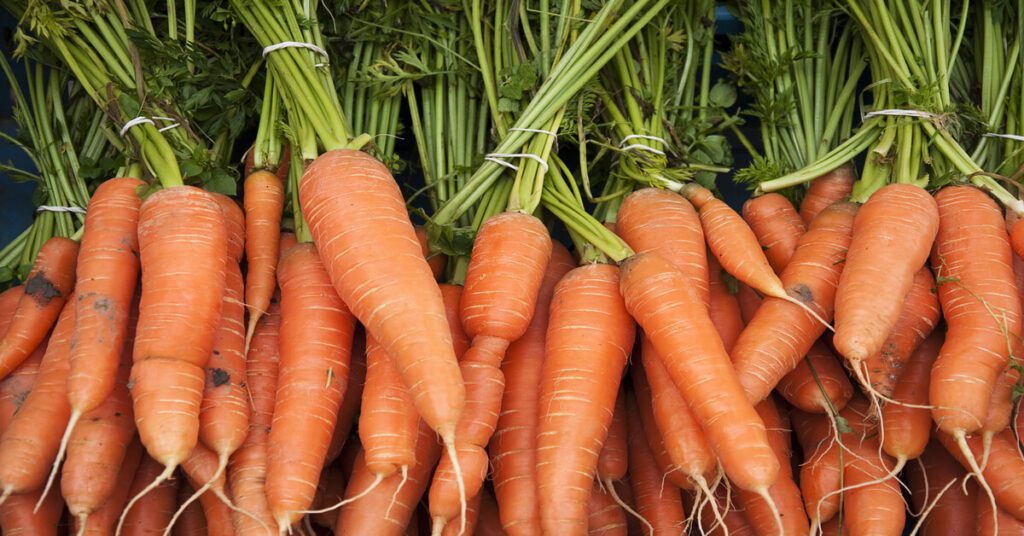Is the Carrot man-made? Yes, the modern orange carrot as we know it is a man-made creation. Resulting from generations of selective breeding by farmers and botanists.
In nature, wild carrots (Dacus carota ssp.) do grow abundantly. But have smaller, paler, and more bitter-tasting taproots (the fibrous part we eat) than cultivated carrots.
Domesticated carrots are cultivars of a singular subspecies of wild carrot, Dacus carota subsp. sativus.
Domesticated and wild carrots belong to the family Apiaceae (aka umbellifers). With over 3,700 species in 434 genera.
Plants in the Apiaceae family, including wild carrots, are known for their aromatic flowers and occasional phototoxicity.
Besides the carrot, popular members include the celery, dill, anise, coriander, parsley, and poison hemlock.
Origins
The earliest form of carrot is the wild carrot. These can still grow alongside grasslands and cliffs. And even next to domesticated carrots.
Wild carrots are quite weedy with small taproots. Archaeologists have discovered seeds at Neolithic campsites in Germany and Switzerland. Going back as far as 2500 B.C.
Wild carrots are Queen Anne’s or Bishop’s lace for their beautiful white flowers. Other names include “cow’s currency.”
The wild carrot was originally used as medicine due to its bitter taste. The botanical name Daucus comes from the Greek for “burn.”
In 900 AD, farmers in Afghanistan started to selectively breed tastier, thicker-rooted versions of the carrot. Which we know today as the domesticated purple carrot. Today, Afghanistan is still the center of the largest variety of carrots.
From there, the purple carrot spread to Iran, Syria, and India before spreading to Europe in the 1300s.
Europeans became frustrated with the purple carrot’s color. Which would turn brown when made into sauces, stews, and soups. The color also stained clothing and hands.
Selective breeding created yellow and orange carrots by the 1600s. That soon outgrew the purple carrot in popularity.
The orange carrot, developed during the reign of William of Orange in the 1600s, soon began to spread and take hold. Due to Dutch nationalism and its more vibrant colors.
The orange carrot, with its better taste, sweeter profile, and more appealing color, spread quickly worldwide.
Varieties of Carrot
Most American shoppers are familiar only with the orange carrot. Carrots come in a wide rainbow of colors, shapes, and flavors.
Here are some popular varieties of carrots:
- Danvers – When people think of a typical carrot, they are most likely thinking of a Danvers carrot. It is known for its long and skinny taproot, which tapers to a point. The name refers to its origin in Danvers, Massachusetts, in 1871
- Imperator – Very similar to the Danvers. This is the most common variety found in American supermarkets. Breeders developed this variety to be thicker, wider, and sweeter than the Danvers. The foliage is also very fast-growing. Popular cultivars include “Japanese Imperial Long,” “Cosmic Red,” and “Sugarsnax 54.”
- Nantes – This type comes in a perfect cylinder shape and is also orange in color. However, the tips at the top and bottom are round. Usually with less foliage, this cultivar originates from the Atlantic coast of France. Where conditions are ideal. There are 40 varieties of popular carrots that fall under this category. Including “Napoli,” “Touchon,” “Napa,” and “White Satin.”
- Chatenay – Chantenay carrots are known for thriving in less-than-ideal rocky soils or containers. These plants develop very top-heavy. And sometimes look like squished regular carrots. With the fat concentrated at the top. The taproot becomes woody if harvested later in the season but stores very well.
- Ball or Mini – This type is known for their miniature size. Which resembles orange turnips or radishes. The short taproot makes them great for container growing.
Besides shape diversity, carrot cultivars also come in a variety of colors as well:

- Purple carrots – Purple carrots are the original varieties grown before the orange color’s dominance. Purple carrots have an intensely sweet flavor and occasionally peppery, earthy taste. In Turkey, people use purple carrots in a popular refreshment called Şalgam. Which is a cool summer drink fermented in barrels with turnips.
- Red carrots – Similar in taste to orange carrots. These red carrots derive their color from the increased presence of lycopene. An antioxidant often found in tomatoes. And known for its beneficial health properties.
- White carrots – These carrots come in a cream or sometimes yellow color. They have a milder flavor without any other carrots’ earthiness. They are also sweeter than orange, red, and purple carrots. Making them good for glazing with butter and sugar.
Which color carrot is the healthiest?
This depends on what nutrients you’re lacking most.
Orange carrots are highest in beta carotene. An antioxidant is associated with better vision and a strong immune system. Purple carrots are high in beta-carotene and anthocyanins. Which guards against cancer and heart disease.
Yellow and purple carrots have lutein, which is good for eye, brain, and heart health. Red carrots are high in lycopene, which guards against heart disease. All carrots are high in fiber, potassium, and vitamin C, which benefit your health.

